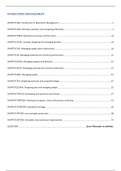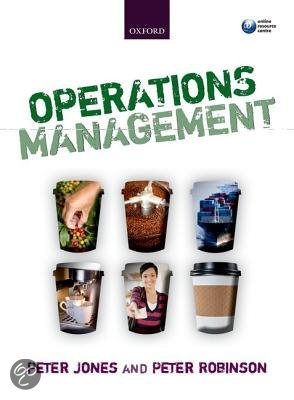OPERATIONS MANAGEMENT
CHAPTER ONE: Introduction to Operations Management .............................................................................................. 2
CHAPTER TWO: Winning customers and competing effectively ..................................................................................... 4
CHAPTER THREE: Operations processes and life cycles ................................................................................................ 10
CHAPTER FOUR: Locating, designing and managing facilities ....................................................................................... 14
CHAPTER FIVE: Managing supply chain relationships ................................................................................................... 18
CHAPTER SIX: Managing materials and inventory performance ................................................................................... 25
CHAPTER SEVEN: Managing capacity and demand ....................................................................................................... 31
CHAPTER EIGHT: Managing queuing and customer satisfaction................................................................................... 37
CHAPTER NINE: Managing quality ................................................................................................................................ 41
CHAPTER TEN: Designing processes and using technology ........................................................................................... 47
CHAPTER ELEVEN: Designing jobs and managing people.............................................................................................. 52
CHAPTER TWELVE: Developing new products and services .......................................................................................... 57
CHAPTER THIRTEEN: Planning for projects, crises and business continuity .................................................................. 61
CHAPTER FOURTEEN: Operations strategy ................................................................................................................... 65
CHAPTER FIFTEEN: Lean and agile production .............................................................................................................. 68
CHAPTER SIXTEEN: Innovation and continuous improvement...................................................................................... 72
QUESTIONS ....................................................................................................................... ¡Error! Marcador no definido.
,CHAPTER ONE: Introduction to Operations Management
Definitions:
- The management of processes that convert inputs (such as materials, labour and energy) into outputs (in the
form of goods and services).
- Everything is produced by people engaged in operations.
- It underpins most of human activity and shapes the society in which we live.
- The planning and organizing of the production of manufactures goods and delivery of services.
- One of the core functions within an organization – the others typically being marketing, human resources
and finance and accounting.
It has evolved over the years. Every person working on their own needs to be organized to ensure that the activity is
done well. So when two or more people come together in order to perform an activity there is an organization. Four
basic issues that need to be addressed in relation to organizational design:
- The nature of the hierarchy it determines the basic shape of an organization, how many people are
between the chief executive officer and the ones on the shop floor. That determines if it is a tall organization
(many layers between) or a flat organization (few layers between).
- The degree of centralization it is all about how power is distributed within an organization. In highly
centralized organizations, power is held at the centre with all decisions about policy and procedure made by
the CEO. In decentralized organizations, low-level managers have delegated authority to make decisions and
take action.
- The extent of formalization this refers to how work is organized and how explicit and rigid this is.
Organizations have a large number of policies, procedures and rules that are typically written down in
standards.
- The level of complexity it refers to the number of subunits within the organization and the degree of
difference between them. Some organizations have a high degree of standardization because they make a
single product or deliver a simple service, they are not complex. Others organizations may make a wide
range of products and deliver services to many different customers in many different locations.
Organizational forms
- Simple form of organization how most SMEs are organized. The original founder or entrepreneur is
typically in charge of all aspects of the business.
- Functional organizations are divided into different areas of management activity: Operations, Sales and
Mkg, HHRR and Accounting and Finance. When it becomes larger, the owner employs specialists in these
functional areas to manage those aspects of the business.
- Divisional or product organizations are either organized around product categories, customer markets or
regions of the world. Then each division will have its own resources and functional organization.
- Conglomerate organizations are made up of a variety of different businesses, which may or may not have
similarities between them.
- Hybrid or matrix organizations are organizations that deliberately mix the four organizational forms just
described. There may be both regional divisions and functional departments.
How is the operations function organized?
The issues that affect the whole organization also affect operations: hierarchy, centralization, formalization and
complexity. Differences between how the operations management function is organized are even more marked
when we compare organizations in different sectors. Operations are always separate from the other functional
areas, but the operations function itself is subdivided on different criteria. The difference between operations and
some other function can be explained by understanding systems behaviour. A system is a clearly identifiable,
regularly interacting or interrelating groups of activities.
2
,Simultaneous multiple containment (SMC) describes how a process may have subprocesses and how these
subprocresses may also be part of a different process. Many systems are interrelated.
What does an operations manager do?
There are key issues in relation to the system that they plan, organize and control. Key responsibilities:
- Developing and maintaining the system’s infrastructure - Assuring the quality of system outputs
- Managing the system inputs and distribution of outputs - Developing and enhancing the system’s processes
- Controlling material inputs within the system - Designing and developing human work systems
- Managing customer inputs within the system - Developing new outputs
- Managing the rate of flow through the system
Managing the short term and long term
A key aspect is the time. Operations managers are responsible for the very short term (operational activity within
the factory on a minute-by-minute basis) but also the very long term (the development and investment in processes
that will lead to the organization’s future success).
Services VS Manufacturing
- Intangibility the lack of tangible characteristics of a service operation. Services do not physically exist but
are directly experienced by consumers. Once a service has been purchased and experienced, there is no
physical evidence of it ever being consumed. It is difficult to ensure services are delivered in the correct way.
Services have tangible features often relate to the environment in which the service is delivered and how
functional it is.
- Heterogeneity the variety of responses consumers may have to a service experience. Consumers have
unique experiences of services that are not shared with other consumers. If there is no tangible product,
then it is easy for each customer to interpret their experience in different ways. For operations managers,
heterogeneity means that managing the customer experience is very challenging. Even the same customer
using the same service on different occasions may have different reactions each time. It is a challenge to
measure consumer satisfaction.
- Perishability it cannot be inventoried or put into stock. The inability of service providers to inventory their
services. Ex. An airline seat available today, if not sold, is therefore a sale that is lost forever. It is essential to
ensure services are used to their maximum.
- Simultaneity (or inseparability) the co-production and delivery of a service in the consumer’s presence.
Services are produce at the same time and place as they are consumed, unlike a product which can be
purchased and used whenever it is needed. A service depends on direct interaction between the consumer
and the service provider. Simultaneity refers to the idea that service is provided at the same time as it is
requested; inseparability refers to providing service in the same place as the consumer.
Processing materials, customers and information
There are basically three types of operations:
- Materials processing operation (MPO) more commonly referred to as manufacturing. Materials are
physical and come in all kinds of shapes and sizes. When not being handled, they remain inert; when being
handled, each kind of material has specific properties. The behaviour of each material can be precisely
understood and managed in any given state.
- Customer processing operation (CPO) typically described as a service. Customers are all made of the same
material, but they have minds of their own. They can physically transport themselves from one place to
another. It is an advantage if they move in the way the operation expects them to but a disadvantage in that
some customers may not choose to cooperate.
3
, - Information processing operation (IPO) mostly considered as services. It is a collection of facts or data. It
is the movement or communication of information from one place to another. Information systems can do
what previously was difficult for humans to do. It is really important to control and process information, so
there are chief information officer (CIO) in the new companies.
An operation is not uniquely one of these three, it is a combination of all three. Ex. Restaurant: MPO (food and
drinks) + CPO (customers’ requests) + IPO (selects the menu)
Operations as systems
Another kind of input is the resources that a firm needs in order to conduct its business. These resources inputs are
called transformational inputs, whereas the inputs that flow through the operation are transformed inputs.
Transformational inputs two kinds: the physical assets of the firm (buildings, machinery equipment) and the
human assets (employees). They can be back of house (unseen or unused by customers) or front of house
(customers enter the operation and use the services provided). Most manufacturing operations have no front of
house, because they don’t process customers.
The servuction system
A model of an operation that identifies the relationship between equipment and employees, and back of house and
front of house. It recognizes that operations which process customers can do so in two ways. This system model
adds another dimension to understanding operations: the co-consumers, the customer experience is affected by
other customers using that operation.
The model is helpful in demonstrating and explaining some of the ways in which customer processing operations
have been changing over the years. The customer has increasingly taken responsibility for their own service and in
effect become a co-worker through using self-service technologies. Service encounters can be high-tech, with little
or no staff input and customers just interacting with technology, or high-touch, with high levels of personal service.
Also, the barrier between back office and front office has disappeared, like in a restaurant where you can see the
kitchen.
CHAPTER TWO: Winning customers and competing effectively
It is essential for successful operations the ability of firms to identify customer needs and to develop an appropriate
range of products or services to meet these needs. This, in turn, increases a firm’s profitability.
Order qualifiers factors (OQs) characteristics of a product or service that are required for it to be considered by a
customer. Having more of these factors won’t give opportunities to do more business.
Order winners factors (OWs) characteristics of a product or service which directly contribute to winning business
from customers. They are the key reasons for customers to purchase goods or services and improving the
performance of these factors may result in increased business.
The concept of OQs enables firms to be clear about what they absolutely must achieve in order to meet the most
basic expectations of their customers and then, OWs enable firms to develop their products and services in such a
way as to give them a competitive edge against other similar firms competing for the same customers.
These factors don’t remain the same over time in as customers’ requirements change, competition increases and
technologies improve. They can change from OQ to OW and they can improve market share. These two factors can
be translated into the following five internal performance objectives.
4






